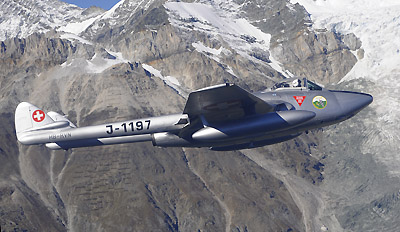|
De Havilland DH-100 Vampire HB-RVN still going strong
Since the end of World War II and the creation of NATO and the Soviet-dominated Warsaw Pact military and political 'power blocks' in Europe, the traditionally neutral Alpine state of Switzerland had no other option than to equip its military forces with as up to date as possible military hardware and to develop an indigineous armement industry (esp. aircraft, artillery and tanks). Partly blessed by its natural terrain characteristics to deter foreign aggression, the Swiss armed forces established a cost-effective and capable self-defence infrastructure.

The continuous technical advance in aircraft design and performances however forced the Swiss air force to frequently invest in more modern aircraft. Similar to the average NATO-air force, an re-investment cyclus of ten years was deemed necessary to remain ' on top of the food chain'. Older but still pristinely maintained aircraft were not withdrawn from operational service but transferred to lesser demanding (f.i. training) roles.

Eventually, not willing to export secondhandly their withdrawn but still servicable aircraft, most older airframes were scrapped. In May 1981 -however- Swiss Air Force Logistics Command auctioned old Pilatus P2-trainers and Dornier Do.27 liaison aircraft for a total of some CHF 730.000. This financial success triggered the Swiss authorities to organise almost a decade later a second 'more ambitious' auction. In January 1991 fifty-three de Havilland DH-100 Mk.6 single- and twenty-eight DH-115 dual-seat Vampire aircraft were auctioned.

One of these Swiss Vampires, auctioned in 1991, was DH-100 J-1197 (c/n 706), built in November 1952 in license by the Eidg Flugzeugwerk (F+W) Emmen and becoming HB-RVN in the process. Nowadays almost sixty years after its 'conception' this twin-boomed 'silver bullet' is still crisscrossing the Swiss aerospace by its present owner Eric Chardonnens |